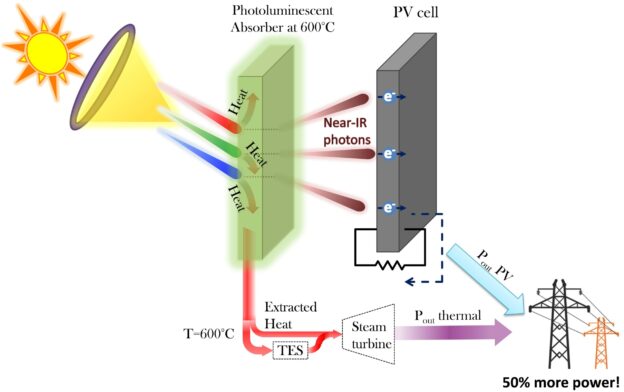The challenge in solar energy today is not the cost of photovoltaics (PVs) electricity generation, already competing with fossil fuel prices, but rather utility-scale energy storage costs. Alternatively, low-cost thermal energy storage (TES) exists but relies on expensive concentrated solar power (CSP). A technology, able to unify PV conversion and TES, may usher in the era of efficient base-load renewable power plants. Spectral splitting, where inefficient photons for PV conversion are redirected and thermally utilized, is economically limited by the low yield of each generator. Operating PVs at high temperatures while utilizing the thermalization induced heat for the thermal cycle is another possibility; yet, while conceptually supporting full utilization of solar energy, it is limited by PV efficiency reduction with temperature increase. My group recently introduced the concept of Luminescence Solar Power (LSP), where sunlight is absorbed in a photoluminescent (PL) absorber, followed by red-shifted PL emission matched to an adjacent PV band-edge. The PL absorber temperature rises due to thermalization, allowing spatial separation between heat and free-energy, for maximal harvesting of both. We solved the material challenge by demonstrating tailored PL with an efficiency of up to 90% while operating at 550oC. At such temperatures, LSP efficiency is 200% higher than conventional CSP and may lead to a reduction in the levelized cost of electricity (LCOE) to below 3¢/kWh
Conceptually, if PV efficiency would tolerate high temperatures, as high as 550°C, for example, it would be beneficial to concentrate solar radiation onto PV cells, harvesting the available free energy while in parallel harvesting high-quality thermal energy through a conventional steam cycle such as exists in CSP. Such a method can potentially surpass any spectral splitting method, where part of the solar spectrum is channeled to the PV while the other is channeled to a heat cycle which falls short by sacrificing heat utilization for PV efficiency or vice versa. Unfortunately, operating PVs at a high temperature cannot be done, as PV efficiency decreases sharply with temperature. Nevertheless, what cannot be done with electrons can be done all-optically. Recently, my group presented and experimentally demonstrated a new concept, Luminescence Solar Power (LSP), where solar radiation is focused onto a photoluminescence (PL) absorber having a high EQE while operating at 550°C. The PL has a narrow line shape emission that can match the band-edge absorption of single or dual-junction PVs, offering concentrated-PV (CPV) above 30% efficiency with minimal heating of the PV. The high-quality heat at the PL-absorber is collected by a heat transfer fluid (HTF) and converted into electricity at a turbine efficiency of 40%. The concept of using PL to separate free energy and high-temperature heat in this manner has never been explored before, even though each component of the system, namely the CPV cells, CSP, and the PL-absorber, rely on well-established technologies. Externally LSP and CSP installations appear the same. The figure above depicts the internal mechanism where the PL-absorber is placed at the focal point of a solar field similar to what is done in CSP. The light is absorbed and re-emitted towards a single or dual-junction PV cell at the back side. A preferred directional emission is achieved by AR-HR coatings. HTF maintains the PL-absorber’s temperature at 550°C while transferring the heat to the turbine operating at 40% efficincy.
- The outcome:
- PV cell operates more efficient – high concentration & low temperature (direct electrical energy)
- The absorber is heated – act as a thermal source for a steam turbine (stored energy)
- Absorber material:
- Rare-earth emitters (Nd3+, Yb3+…) → Narrow emission to match the PV band-edge, stable External quantum efficiency (EQE) at high temperatures.
- Adding Cr3+ → enhanced solar absorption, efficient energy transfer to the rare-earth emitters.
- YAG/Silica… → Transparent, thermally stable, efficient host for rare-earth emitters.
- Experimental results:
- High absorption up to 650 nm
- EQE of 90% @ 600°C
- Total device efficiency of above 40% with 30% storage is in reach.
Current status:
We started working on a heat engine that is soo cheap, allowing modular CSP without the need for PL crystals, see heat engine item.

